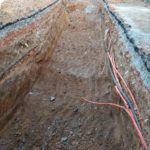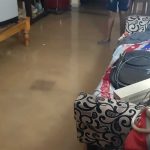Sector 6 and 7 residents form the HSR CAT Force
By PRADEEP NAGRAJ
The HSR residents were greeted on Independence Day by waves of sewage water washing up their doors and entering homes, that raise a stink. Roads were filled with sewage water, and cars were floating around. Boats and fire engines rushed to rescue people and pump out water. The flooding woes continued in HSR for almost three months, while the authorities did nothing to stop further damage.
The residents of Sector 6 and 7 created a Whatsapp group and called it the HSR Civic Action Task (CAT) Force. Their single-minded focus was to solve the flooding issue. “First, there was a road block by the affected residents at the Sweet Chariot signal,” says its vocal member IN Murthy. “This caught the attention of officials and public representatives.” Adding to their anger was the lack of support from the Residents Welfare Association (RWA). “No RWA member approached any of these affected residents. That’s when the HSR CAT Force decided to take matter into their hands.”
The members met Bommanahalli MLA Satish Reddy several times and even raised the issue at the national level by getting Bangalore South MP Ananth Kumar to visit the affected localities. It was made clear to him that the affected residents were living in BBMP-created low-lying pockets because the surrounding main road levels were increased unwittingly by the BBMP. The drain depths were lessened to less than six inches, which were earlier about three feet deep. After several follow-up meetings with him along with MLA, Opposition leader BBMP Padmanabha Reddy, BBMP engineers, an interim relief was provided — the required number of pumps and pipes were brought to remove the sewage water from these flooded pockets.
This was followed with visits by the Chief Minister and his many ministers, who promised the release of funds to solve the flooding problem. However, with no urgency being shown and their priorities elsewhere, the residents wondered whether all of this is mere eyewash.
HSR CAT force members, predominantly active due to senior citizens and women, held regular meetings and brainstormed to find out how the flooding can be avoided in 2018. Chief engineers of Storm Water Drain divisions visited the area. A Special Commissioner was appointed and a meeting was set up with Mayor and later, the BBMP Commissioner. Several timelines for various tasks towards flood management were given but most are yet to begin, even after three months. Based on the analysis of BBMP Engineers and inputs given by residents, a detailed project report (DPR) was to be prepared. This DPR was supposed to be scrutinised by an expert agency, STUP Consultants, and approved.
Last month, the HSR CAT Force organised a ‘Clean HSR Walkathon’ on December 3 to bring people together and invite all the stakeholders to visit HSR and walk along the routes most affected by flooding. The invitees included Mayor Sampath Raj, Rajya Sabha MP Kupendra Reddy, Bommanahalli MLA Satish Reddy, MLC VC Ugrappa, HSR Corporator Gurumurthy Reddy, Additional Chief Secretary Mahendra Jain, BBMP Commissioner Manjunatha Prasad and BBMP Joint Commissioner (Bommanahalli) Veerabhadra Swamy. Hundreds of residents participated and apprised them of their problems and demanded their right for a well-designed storm water drain system and an effective sewage management system.
The solutions to the flooding are now feasible, thanks to STUP’s detailed HSR map that has the terrain and topology that shows the low-lying areas. Some of the remedies for Sector 6 and 7 are as follows…
Desilting 5th Main, 9th Main and Outer Ring Road: These storm water drains have not been desilted for the last 20 years. Removing the silt will increase the depth of drains and their carrying capacity. A mesh at the entry point of Mangammanapalya will prevent garbage clogging into these stormwater drains (SWDs). People around these SWDs, both residential and commercial, have to be educated to not throw garbage or connect sanitary lines to these SWDs.
Gate management system: BBMP has to install gates at critical junctions of the SWDs upstream of HSR layout to regulate the flow of water into the SWDs in HSR Layout. This will decrease the water into Sector 6 and 7 and allow time for water to flow out of these pockets without flooding the roads. A water holding pond is also suggested, one each in Sector 6 and Sector 7 based on its terrain and topology.
Diversion of water flow: Rain water mixed with sewage water from Begur, Hongasandra and Mangammanapalya fills several lakes and flows down towards HSR Layout. This water has to be diverted along the 9th Main box drain and a new drain downstream has to be built on Outer Ring Road that will flow into Bellandur Lake.
Sewage management: The sewage water should be prevented from being let into the SWDs. Sewage lines are overloaded and this flow into the pipes has to be diverted. The manholes and pipes also need to be desilted.
“Though the rains stopped two months ago, the sewage is still entering the houses in 6th and 7th sector,” says Murthy. “These three measures should give great relief from flooding. However, there are other additional measures suggested which are not unanimously approved by the experts. For example, the new internal drains have to be taken up only after the above measures are completed, otherwise they will carry the excess sewage mixed water from Mangammanapalya and other areas from the main SWDs into the interior pockets. The extent of ground water contamination also needs to be considered.”




